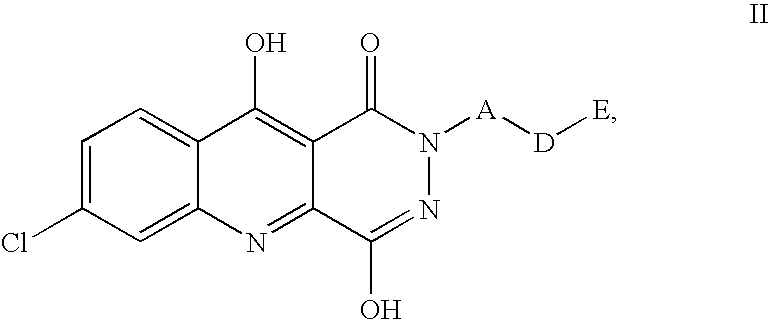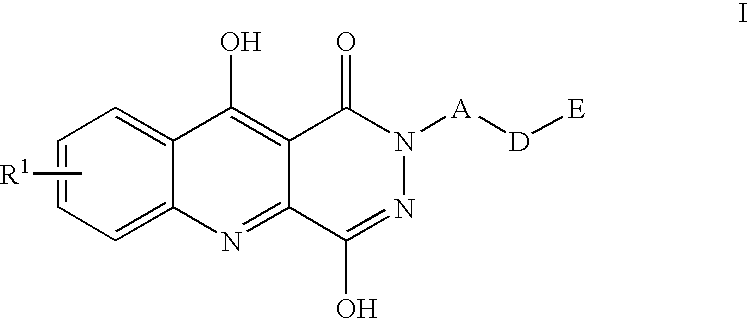1,2,5,10-tetrahydropyridazino{4,5-b}quinoline-1,10-diones and their use for the treatment of pain
- Summary
- Abstract
- Description
- Claims
- Application Information
AI Technical Summary
Benefits of technology
Problems solved by technology
Method used
Image
Examples
example 1
7-Chloro-4-hydroxy-2-(3-(4-pyridyl)prop-2-ynyl)1,2,5,10-tetrahydropyridazino[4,5-b]quinoline-1,10-dione 1,3 methanesulfonate. (tert-Butoxy)-N-(pron-2-ynylamino)carboxamide
A 5 liter three-necked flask equipped with mechanical stirrer, thermometer and 500 mL dropping funnel with nitrogen inlet, was charged with powdered potassium carbonate (124.03 g, 0.8975 mol), tert-butyl carbazate (355.4 g, 2.692 mol), and 2700 mL of 9:1 THF:DMF. To this stirred slurry was added a solution of propargyl bromide (100 mL, 0.898 mole, of 80% in toluene), which was dissolved in 300 mL of 9:1 THF:DMF, over 1.5 hrs. The reaction was stirred at ambient temperature for 44 hrs. and the contents were then concentrated. The residue was partitioned between 1500 mL of DCM and 2000 mL water. The aqueous layer was extracted with DCM (2×500 mL) and the combined organics were washed once with 1000 mL water / 200 mL brine and then several times with 400 mL water / 100 mL brine. The organic layer was dried over Na2SO4 a...
example 2
7-Chloro-4-hydroxy-2-[3-(3-chlorophenyl)prop-2-ynyl]-1,2,5,10-tetrahydropyridazino[4,5-b]quinoline-1,10-dione.
N-[(tert-Butoxy)carbonylamino][7-chloro-4-oxo-2-(pyrrolidinylcarbonyl)(3-hydroquinolyl)]-N-(3-(3-chlorophenyl)prop-2-2-ynyl)carboxamide.
A solution of 3-chloroiodobenzene (0.303 g, 1.27 mmol), dichlorobis-(triphenylphosphine)palladium(II) (25 mg, 0.036 mmol) and copper(I) iodide (12.7 mg, 0.067 mmol) in chloroform (10 mL) was stirred at room temperature under argon for 5 minutes. To the resulting dark yellow solution was added N-[(tert-butoxy)-carbonylamino][7-chloro-4-oxo-2-(pyrrolidinylcarbonyl)(3-hydroquinolyl)]-N-prop-2-ynylcarboxamide (0.604 g, 1.28 mmol) and triethylamine (0.5 mL, 0.36 g, 3.6 mmol) and the resulting orange solution was refluxed under argon for 1.5 hr and then cooled to room temperature. The reaction mixture was poured into an excess of 1% aqueous hydrochloric acid and an additional 40 mL of chloroform was added. The chloroform layer was separated fr...
example 3
7-Chloro-4-hydroxy-2-[3-(4-chlorophenyl)prop-2-ynyl]-1,2,5,10-tetrahydropyridazino[4,5-b]quinoline-1,10-dione.
The title compound was prepared by the method described Example 2 from 4-chloroiodobenzene. Yield 89%; mp 251-252° C.; MS (CI) m / z 412 / 414; 1H NMR (300 MHz, DMSO-d6): δ 4.97 (s, 2H), 7.45 (s, 5H), 8.03 (s, 1H), 8.15 (d, 1H, J=8.7 Hz), 11.98 (br s, 1H, exchangeable), 12.86 (br s, 1H, exchangeable). Calc'd for C20H11Cl2N3O3.0.5H2O C, 57.03; H, 2.87; N, 9.98; Found: C, 57.23; H, 3.06; N, 9.75
PUM
| Property | Measurement | Unit |
|---|---|---|
| Molar density | aaaaa | aaaaa |
| Molar density | aaaaa | aaaaa |
| Molar density | aaaaa | aaaaa |
Abstract
Description
Claims
Application Information
 Login to view more
Login to view more - R&D Engineer
- R&D Manager
- IP Professional
- Industry Leading Data Capabilities
- Powerful AI technology
- Patent DNA Extraction
Browse by: Latest US Patents, China's latest patents, Technical Efficacy Thesaurus, Application Domain, Technology Topic.
© 2024 PatSnap. All rights reserved.Legal|Privacy policy|Modern Slavery Act Transparency Statement|Sitemap



